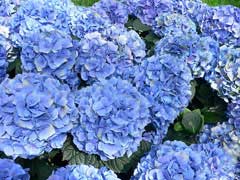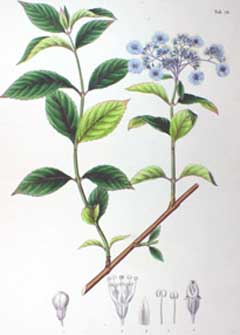 |
|
http://commons.wikimedia.org/wiki/User:Raul654Hydrangea paniculata |
 |
| http://commons.wikimedia.org/wiki/File:Hydrangea_macrophylla_SZ58.png |
Translate this page:
Summary
Bloom Color: Blue, Lavender, Pink, Purple, Red, White. Main Bloom Time: Early summer, Early spring, Late summer, Late spring, Mid summer, Mid spring. Form: Rounded.
Physical Characteristics

 Hydrangea macrophylla is a deciduous Shrub growing to 3 m (9ft) by 3 m (9ft) at a medium rate.
Hydrangea macrophylla is a deciduous Shrub growing to 3 m (9ft) by 3 m (9ft) at a medium rate.
See above for USDA hardiness. It is hardy to UK zone 5 and is not frost tender. It is in flower from July to September. The species is hermaphrodite (has both male and female organs) and is pollinated by Bees.
Suitable for: light (sandy), medium (loamy) and heavy (clay) soils and prefers well-drained soil. Suitable pH: mildly acid, neutral and basic (mildly alkaline) soils and can grow in very acid soils.
It can grow in semi-shade (light woodland) or no shade. It prefers moist soil. The plant can tolerate maritime exposure.
UK Hardiness Map
US Hardiness Map
Synonyms
H. maritima.
Plant Habitats
Woodland Garden Sunny Edge; Dappled Shade; Hedge;
Edible Uses
Edible Parts: Leaves Shoots
Edible Uses: Sweetener
The young leaves, when dried and rubbed between the hands, become very sweet and are used to make a sweet tea called 'tea of heaven', it is used in Buddhist ceremonies[183]. The leaves contain phellodulcin (its chemical formula is C16 H14 O), a very sweet substance that can be used as a sugar substitute[116, 183]. One small leaf is sufficient to sweeten a cup of tea[218]. The older leaves can be dried, powdered and used as a flavouring on foods[105, 177]. The young leaves and shoots are also eaten cooked[105, 177]. Young leaves contain the toxin hydrocyanic acid, this reduces as the leaves grow older, often to zero levels[218].
References More on Edible Uses
Medicinal Uses
Plants For A Future can not take any responsibility for any adverse effects from the use of plants. Always seek advice from a professional before using a plant medicinally.
Antiperiodic Antitussive Diuretic Malaria
The leaves, roots and flowers are antimalarial, antitussive and diuretic[218, 240]. They are said to be a more potent antimalarial than quinine, due to the presence of an alkaloid[240].
References More on Medicinal Uses
Now available: PLANTS FOR YOUR FOOD FOREST: 500 Plants for Temperate Food Forests and Permaculture Gardens.
An important new book from PFAF. It focuses on the attributes of plants suitable for food forests, what each can contribute to a food forest ecosystem, including carbon sequestration, and the kinds of foods they yield. The book suggests that community and small-scale food forests can provide a real alternative to intensive industrialised agriculture, and help to combat the many inter-related environmental crises that threaten the very future of life on Earth.
Read More
Other Uses
Hedge Hedge
A useful hedging plant because of its vigorous growth. The Hortensias or mop-head cultivars are recommended[200].
Special Uses
Hedge Hedge
References More on Other Uses
Cultivation details
Landscape Uses:Container, Seashore, Specimen. Tolerates most soil[200], thriving in a well-drained loamy soil[1], but resenting dryness at the roots[11, 200]. Succeeds in full sun or semi-shade[200], but if it is grown in a low rainfall area then it requires shade at the hottest part of the day[11]. Prefers a shady position[1]. Does well on very acid soils with a pH around 4.5[200]. Plants also tolerate alkaline soils, though they become chlorotic on shallow soils over chalk[200]. The colour of the flowers reflects the pH of the soil the plant is growing in, the flowers are pink in a neutral to alkaline soil and blue in an acid soil[200]. A very wind resistant plant when grown in mild areas[166]. Dormant plants are hardy to about -10°c[184], though the young growth in spring is frost-tender[K]. A very ornamental plant and polymorphic species[200], there are many named varieties[184]. This species was named for a sterile (or 'mop head') cultivar so that the true species should really be referred to as H. macrophylla normalis[182]. Plants are cultivated for their leaves in China and Japan. Plants are very tolerant of pruning and can be cut back into old wood if required[188]. This species is notably susceptible to honey fungus[200]. Special Features:Not North American native, All or parts of this plant are poisonous, Suitable for cut flowers, Suitable for dried flowers, Blooms are very showy.
References Carbon Farming Information and Carbon Sequestration Information
Temperature Converter
Type a value in the Celsius field to convert the value to Fahrenheit:
Fahrenheit:
The PFAF Bookshop
Plants For A Future have a number of books available in paperback and digital form. Book titles include Edible Plants, Edible Perennials, Edible Trees,Edible Shrubs, Woodland Gardening, and Temperate Food Forest Plants. Our new book is Food Forest Plants For Hotter Conditions (Tropical and Sub-Tropical).
Shop Now
Plant Propagation
Seed - surface sow in a greenhouse in spring[113]. Cover the pot with paper until the seed germinates[78]. When they are large enough to handle, prick the seedlings out into individual pots and grow them on in the greenhouse for at least their first winter. Plant them out into their permanent positions in late spring or early summer, after the last expected frosts. Cuttings of half-ripe wood, 8cm long, July/August in a frame. Overwinter in a greenhouse and plant out in late spring[78]. Cuttings of mature wood in late autumn in a frame[200]. Mound layering in spring. Takes 12 months[78]. Leaf-bud cuttings of the current seasons growth in a frame[200].
Other Names
If available other names are mentioned here
Battien, Hottangxia, Kembang bokor,
Native Plant Search
Search over 900 plants ideal for food forests and permaculture gardens. Filter to search native plants to your area. The plants selected are the plants in our book 'Plants For Your Food Forest: 500 Plants for Temperate Food Forests and Permaculture Gardens, as well as plants chosen for our forthcoming related books for Tropical/Hot Wet Climates and Mediterranean/Hot Dry Climates. Native Plant Search
Found In
Countries where the plant has been found are listed here if the information is available
Asia, Australia, Britain, China, Hawaii, India, Indochina, Indonesia, Japan, Myanmar, Pacific, SE Asia, USA, Vietnam,
Weed Potential
Right plant wrong place. We are currently updating this section.
Please note that a plant may be invasive in one area but may not in your area so it’s worth checking.
Conservation Status
IUCN Red List of Threatened Plants Status :

| Related Plants
|
| Latin Name | Common Name | Habit | Height | Hardiness | Growth | Soil | Shade | Moisture | Edible | Medicinal | Other |
| Clerodendrum bungei | Glory Flower, Rose glorybower, Cashmere Bouquet, Mexican Hydrangea, Glory Bower | Shrub | 2.0 |
7-9
| M | LMH | N | M | 0 | 1 | 0 |
| Deinanthe bifida | | Perennial | 0.4 |
6-9
| S | LM | FS | M | 1 | 0 | |
| Deutzia scabra | Fuzzy pride-of-rochester, Deutzia | Shrub | 3.0 |
5-8
| M | LMH | SN | M | 1 | 0 | 2 |
| Dichroa febrifuga | Chinese Quinine, Dichroa | Shrub | 2.0 |
8-11
| M | LMH | SN | M | 0 | 3 | 1 |
| Hydrangea anomala | Hydrangea | Climber | 12.0 |
4-8
| F | LMH | FSN | M | 3 | 1 | 3 |
| Hydrangea arborescens | Seven Barks, Wild hydrangea, Ashy Hydrangea, Snowhill Hydrangea, Smooth Hydrangea | Shrub | 3.0 |
4-9
| M | LMH | SN | M | 1 | 3 | |
| Hydrangea aspera | Hydrangea | Shrub | 4.0 |
7-9
| M | LMH | SN | DM | 1 | 0 | |
| Hydrangea hirta | | Shrub | 1.0 |
6-9
| | LMH | SN | M | 1 | 0 | |
| Hydrangea paniculata | Panicled hydrangea, Hybrid Hydrangea, PeeGee Hydrangea, Panicle Hydrangea | Shrub | 4.0 |
3-8
| F | LMH | SN | MWe | 1 | 2 | 2 |
| Hydrangea serrata | Hydrangea, Mountain Hydrangea, Sawtooth Hydrangea | Shrub | 2.0 |
5-9
| M | LMH | SN | M | 2 | 0 | 3 |
| Hydrangea serrata amagiana | | Shrub | 2.0 |
5-9
| | LMH | SN | M | 4 | 0 | 2 |
| Hydrangea serrata thunbergii | Tea of heaven, Ama-tsja, | Shrub | 1.5 |
5-9
| | LMH | SN | M | 3 | 0 | 2 |
| Philadelphus coronarius | Mock Orange, Sweet mock orange | Shrub | 4.0 |
4-8
| F | LMH | SN | M | 0 | 0 | 1 |
| Philadelphus delavayi | | Shrub | 4.0 |
5-9
| | LMH | SN | M | 0 | 0 | 1 |
| Philadelphus lewisii | Mock Orange, Lewis' mock orange | Shrub | 3.6 |
4-8
| | LMH | SN | M | 0 | 1 | 3 |
| Philadelphus microphyllus | Littleleaf Mock Orange | Shrub | 1.2 |
5-9
| | LMH | SN | DM | 1 | 0 | 1 |
| Philadelphus pubescens | Hoary mock orange | Shrub | 5.0 |
5-9
| | LMH | SN | M | 0 | 0 | 1 |
| Philadelphus purpurascens | | Shrub | 4.0 |
5-9
| | LMH | SN | DM | 0 | 0 | 1 |
| Philadelphus x virginalis | Mock Orange | Shrub | 3.0 |
5-8
| M | LMH | SN | M | 0 | 0 | 1 |
| Platycrater arguta | | Shrub | 1.0 |
7-10
| | LMH | S | M | 1 | 0 | 3 |
| Schizophragma hydrangeoides | Japanese Hydrangea Vine | Climber | 12.0 |
5-8
| S | LMH | FSN | M | 1 | 0 | 3 |
| Schizophragma integrifolium | | Climber | 12.0 |
6-9
| | LMH | FSN | M | 0 | 2 | 3 |
|
Growth: S = slow M = medium F = fast. Soil: L = light (sandy) M = medium H = heavy (clay). pH: A = acid N = neutral B = basic (alkaline). Shade: F = full shade S = semi-shade N = no shade. Moisture: D = dry M = Moist We = wet Wa = water.

Expert comment
Author
(Thunb.)Ser.
Botanical References
1158200
Links / References
For a list of references used on this page please go here
Readers comment